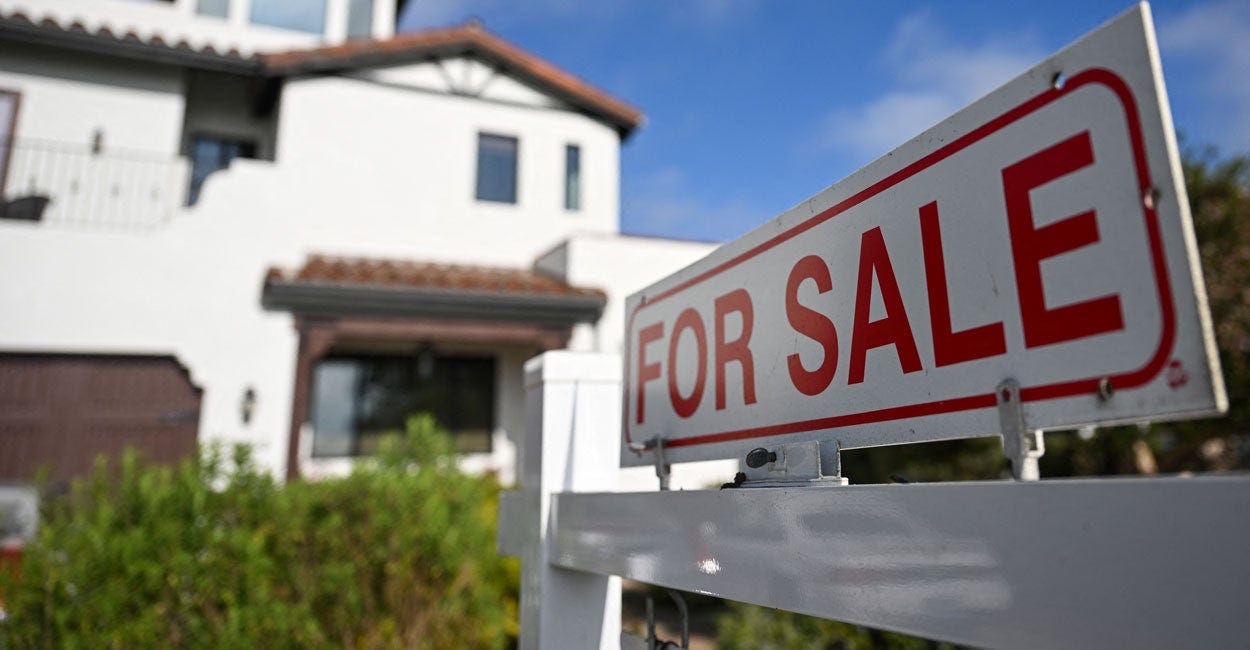Econ 101: Free Trade = More Freedom | This Week's Economy Ep. 119
Sound economic principles to counter Washington’s protectionist myths.
Hello Friends!
There's no shortage of economic confusion in Washington, from tariffs and trade wars to myths about trade deficits. But these misguided narratives lead to bad policies that raise consumer costs, hurt workers, and weaken America’s economy.
Let’s set the record straight.
Tariffs don’t create jobs—they destroy them. Protectionism raises prices, stifles innovation, and undermines our competitiveness. It’s time to get back to economic basics.
During This Week’s Economy, I’m breaking down what trade is, why it matters, and how free markets—not government planners—create prosperity. Watch the full episode on YouTube, Apple Podcast, or Spotify, and visit my website for more information.
1. What is Voluntary Exchange?

Quick Lesson:
Trade is a voluntary exchange—people giving up something they value less to get something they value more. It’s how individuals and businesses improve their lives across towns or borders. Economists agree: free trade makes everyone better off.
“In a free trade, an effectual combination cannot be established but by the unanimous consent of every single trader, and it cannot last longer than every single trader continues of the same mind.” – Adam Smith, The Wealth of Nations
Real-World Examples:
Gains from trade mean both parties gain from an exchange, which is why markets work. A Texas rancher can trade beef for Florida oranges. Each focuses on what it does best and swaps to get more of what it wants.
Markets make this possible by coordinating decisions through prices, which reflect real-time information about supply, demand, and value. But when the government gets in the way, those price signals break down.
Why It Matters:
Free trade is the ability of individuals to meet in a marketplace and mutually benefit from voluntary exchange. Trade is how we create wealth. We raise incomes and living standards by focusing on what we do best and trading for the rest. That’s true at home and abroad.
2. Why Do We Need Trade?

Quick Lesson:
Trade expands opportunity. It leads to better jobs, lower prices, and more peace. People—not governments—trade. And when they do, they’re less likely to fight.
“Economics therefore concludes that the only basic principle by which a community or society can get by is the principle of productive work.” – Milton M. Shapiro, Foundations of the Market Price System
Real-World Examples:
Specialization and the division of labor are foundations of prosperity. When individuals focus on what they do best and trade for what they need, everyone produces more, earns more, and lives better.
Adam Smith called absolute advantage when a person or country can produce more of something in a given period than others. But that does not explain the true gains of trade because in some situations, there would be a case when someone or a country has an absolute advantage in most, if not all, things, so that they wouldn’t trade.
David Ricardo improved on this with comparative advantage if they can produce more in a given period relative to what others can provide of something else. This creates incentives to trade so both mutually benefit from the exchange, and is the main force driving us to use our talents in the jobs that we do best.
Why It Matters:
Trade allows people to specialize, be more productive, and focus on what they do best. That leads to more abundance, not less. This means trade isn’t just about economics—it’s about freedom. Letting people decide how to create and exchange value is core to a free society.
3. How Does Free Trade Make Us Better Off?

Quick Lesson:
When Americans get to choose how to spend, invest, and produce, they grow wealth. When the government picks winners and losers through tariffs, it distorts choices, limits competition, and reduces prosperity. That’s not putting America first—it’s putting politics ahead of people.
Free markets allow Americans to choose. Tariffs take that choice away.
“That is why voluntary trade is so beneficial for humans: it allows people with ‘reverse valuations’ to swap goods so that everyone is happier with the new arrangement compared to the original distribution of property.” – Art Laffer
Real-World Examples:
It doesn’t matter whether you’re a welder in Iowa buying equipment from Indiana or a farmer in Texas exporting grain to Taiwan. Trade happens when people can choose what’s best for their families, businesses, and communities.
Free trade is a cornerstone of economic freedom, driving competition, innovation, and lower prices. Conversely, protectionist policies like tariffs stifle growth, increase government control, and burden businesses with unnecessary costs.
Why It Matters:
Trade hasn’t hollowed out manufacturing—automation, productivity gains, and bad policies by the federal, state, and local governments in those places. The U.S. output in manufacturing is near record highs, but employment has declined due to automation and gains in productivity. The solution isn’t to punish consumers with higher prices. It’s to fix tax, regulatory, and spending policies holding investment and innovation back.
4. APPLYING PRINCIPLES TODAY
Within the framework of international trade, there is a place for government involvement, but that involvement should be focused on ensuring cross-border enforcement of contracts (i.e., property rights), not imposing tariffs, quotas, or labor or environmental regulations on those trading. This focus also allows governments to engage one another in “free trade” agreements to remove existing barriers to trade.
Trade Deals:
Trade deals like the Trans-Pacific Partnership would have enhanced America’s influence in Asia and set higher standards for international commerce. By walking away, we ceded ground to China. We need more trade agreements—built on reducing trade barriers—that can reinforce our leadership and lift incomes at home and abroad.
Trade deals can also be done through business deals. Nippon Steel’s acquisition of U.S. Steel is a strong signal that the U.S. is open for business and welcomes a $21 billion investment in American workers, factories in Pennsylvania and Indiana, and the overall steel industry. It’s the exact type of foreign investment Trump has been promising since he entered politics a decade ago. This will sideline China, strengthen U.S. economic relationships, and support domestic manufacturing. But it would have been better if there were fewer mandates from the “deal.”
Protectionist Policies:
A trade deficit is not a sign of economic weakness — it reflects strong capital inflows and consumer purchasing power. Whether it is sourcing goods that the U.S. no longer produces or which can be made more cheaply elsewhere, significant American import levels reflect strong demand from consumers for stuff. The U.S. economy and Americans generally benefit from this arrangement, or people wouldn’t trade.
Tariffs don’t hurt just businesses; they also hit working-class Americans the hardest. Trump’s tariffs are one of modern history's most significant tax increases, ranking as the biggest tax hike since 1993 and the 18th largest since 1940. The new trade war is projected to reduce after-tax incomes by 0.8% in 2025, with middle- and lower-income households bearing the brunt of rising consumer costs.
Texas:
In 2023, Texas exported and imported billions of dollars in goods and services to Mexico and Canada, a vital trade supporting many Texas jobs. Protectionism through government-imposed tariffs distorts markets, reduces competition, and forces Americans to pay higher prices.
Raising taxes through tariffs is a costly mistake that hurts Texans. A 25% tariff on goods from Mexico and Canada would disproportionately harm Texas, the nation's top trading state with these countries, by raising costs for businesses and consumers, disrupting supply chains, and reducing economic efficiency.
Final Thoughts
Respect for trade is more critical now than ever.
If we want an economy that works for people—not politicians—we must let markets do their job. Trade allows us to specialize, raise incomes, and grow wealth. It’s not a threat—it’s a pillar of prosperity. Let’s return to the first principles: trust markets and embrace trade.
Let people trade freely. And Let People Prosper!
RESOURCES
Here are some recommended resources to dive deeper into studying economics:
Foundations of the Market Price System by Milton M. Shapiro
Exchange and Trade Guide by EconLib
Tyler Cowen’s Idea #3: Gains from Trade by Marginal Revolution University
Exposing Trade Myths & Defending Economic Liberty with Joel Griffith Let People Prosper Ep. 144
Free Trade, Not Protectionism, Is the Path to Prosperity, my commentary at InsideSources.
Comparative Advantage by Marginal Revolution University
Thanks for joining me in this week’s episode. For more resources and commentary, visit VanceGinn.com and subscribe to my Substack at vanceginn.substack.com. God Bless You! Let People Prosper!
THANK YOU for being a paid subscriber!
Don’t miss this short video from the entire episode.
Free Trade: How it Boosts Prosperity & Opportunity
More from Me:
Trump’s ‘Art of the Deal’ Politics Undermine America’s Future my recent commentary in The Daily Economy.
"Affordable" Houston Area Homes Becoming... Less Affordable my recent conversation on KTRH.
My Latest Commentary at The Daily Signal.
Why It’s Time to Privatize Fannie and Freddie to Fix America’s Housing Market
The federal government’s grip on America’s housing finance system is contributing to the very affordability crisis it claims to solve.
Fannie Mae and Freddie Mac, two government-controlled mortgage giants, now back more than half the $16 trillion residential mortgage market. While they don’t issue loans directly, they purchase mortgages from lenders and securitize them, funneling credit through a government-directed system that distorts prices, encourages risk-taking, and leaves taxpayers exposed.
Now, under the direction of Federal Housing Finance Agency Director Bill Pulte, the Trump administration has reopened the long-stalled debate over what to do with these entities.
President Donald Trump recently pledged to take Fannie and Freddie public again, and Pulte has said the administration is considering how to do so while still keeping them in federal conservatorship. This contradictory posture—suggesting privatization while maintaining government control—has left markets, lawmakers, and taxpayers uncertain.
That uncertainty matters because the status quo is already creating long-term damage. Fannie and Freddie have been in conservatorship since the 2008 financial crisis, when their collapse required a $187 billion bailout funded by taxpayers. That was supposed to be a temporary fix. Instead, they’ve become permanent fixtures of the federal housing system, with an outsized footprint that crowds out private competition and weakens the incentives for prudent lending.
Nevertheless, the Trump administration is right—privatization is the answer here. However, it must be real privatization. While the White House can take a phased approach to removing their conservatorship, eventually, it must come off.
Critics of reform argue that ending federal backing could lead to higher mortgage rates. But those same critics ignore the long-term cost of the current arrangement. When lenders and investors operate with the understanding that the federal government stands behind their losses, the result is a mispricing of risk. The implicit guarantee that Washington will step in when things go south may keep rates lower in the short term, but it inflates home prices, misallocates credit, and leaves taxpayers holding the bag when the cycle turns.
The government’s role has also expanded in troubling ways. In January, the FHFA raised conforming loan limits to a record high of $806,500. These loans are now eligible for federal backing, meaning taxpayers subsidize million-dollar mortgages. That’s not a policy targeted at helping working families. It’s a distortion that inflates demand in already expensive markets and rewards politically connected interests at the expense of long-term affordability.
Meanwhile, the real challenge—supply—goes largely unaddressed. According to Axios, the U.S. faces a shortage of nearly 4 million homes. Easier credit does nothing to solve that. In fact, when supply is constrained, subsidizing demand only pushes prices higher.
The solution isn’t more government-backed debt. It’s more homes. And that requires less regulation and more room for private capital to operate.
According to the National Association of Home Builders, nearly $94,000 of the cost of an average new home is attributable to local, state, and federal regulation. Those barriers choke off new construction, especially in places where demand is strongest. The answer isn’t more government-subsidized credit; it’s a freer, more responsive market.
We’ve already seen the benefits of private capital stepping in to increase supply. Private ownership of newly built rental units has grown sharply—by nearly 70% in some areas—bringing stability and options to markets that would otherwise be constrained. Yet instead of encouraging this private-sector dynamism, some in Washington want to shut it down. Lawmakers have floated proposals to ban corporate homebuyers, cap investor purchases, or impose new restrictions on private equity in housing.
These misguided efforts mirror the broader failure of Washington’s housing policy: punishing private capital while doubling down on federal programs like Fannie and Freddie that drive up costs and distort incentives. Instead of vilifying the private sector, policymakers should welcome its role in helping lower housing costs and increasing housing supply. Privatizing Fannie and Freddie would represent a great place to start.
Fannie and Freddie were never meant to be permanent arms of the federal government. Their continued dominance—underwritten by taxpayers and controlled by regulators—creates a housing system built on political priorities instead of market signals.
Privatizing them would correct these distortions. It would restore risk-based pricing to mortgage markets, reduce taxpayer exposure, and invite new entrants and innovation into the system. A phased release from conservatorship—paired with a clear plan to reduce implicit guarantees—would allow a competitive private housing finance market to emerge, while maintaining stability during the transition.
Preserving the current model doesn’t protect affordability—it protects dysfunction. If the Trump administration is serious about improving access to housing and restoring fiscal responsibility, it must finish the job: end the conservatorship, get government out of the way, and let the housing market function like a market again.




